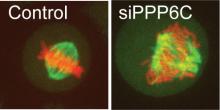Regulation of spindle formation

Bipolar spindle formation is an essential prerequisite for the successful segregation of the genetic material during cell division. Despite numerous advances in our understanding of how mitotic spindles are built, how bipolarity is achieved and maintained is still not fully understood. In a screen for regulators of bipolar spindle formation we identified the PP2A-family phosphatase PP6 as a key regulator of this process (Zeng et al., 2010). The main target of PP6 phosphatase activity during mitosis is the kinase Aurora A, one of the key drivers of bipolar spindle formation. PP6 regulates the T-loop phosphorylation of Aurora A and thereby controls the levels of active Aurora A. Loss of PP6 activity, as present in many skin cancers, results in hyperactive Aurora A, dysregulated spindle formation and inefficient chromosome segregation (see live cell imaging of chromosomes of PP6-depleted cells, below). Affected cells suffer from aneuploidy and micronucleation, hallmarks of tumorigenesis. Our current work focuses on understanding how the interplay between Aurora A and PP6 ensures correct chromosome segregation and how the equilibrium of phosphorylation and dephosphorylation is controlled during the cell cycle.
